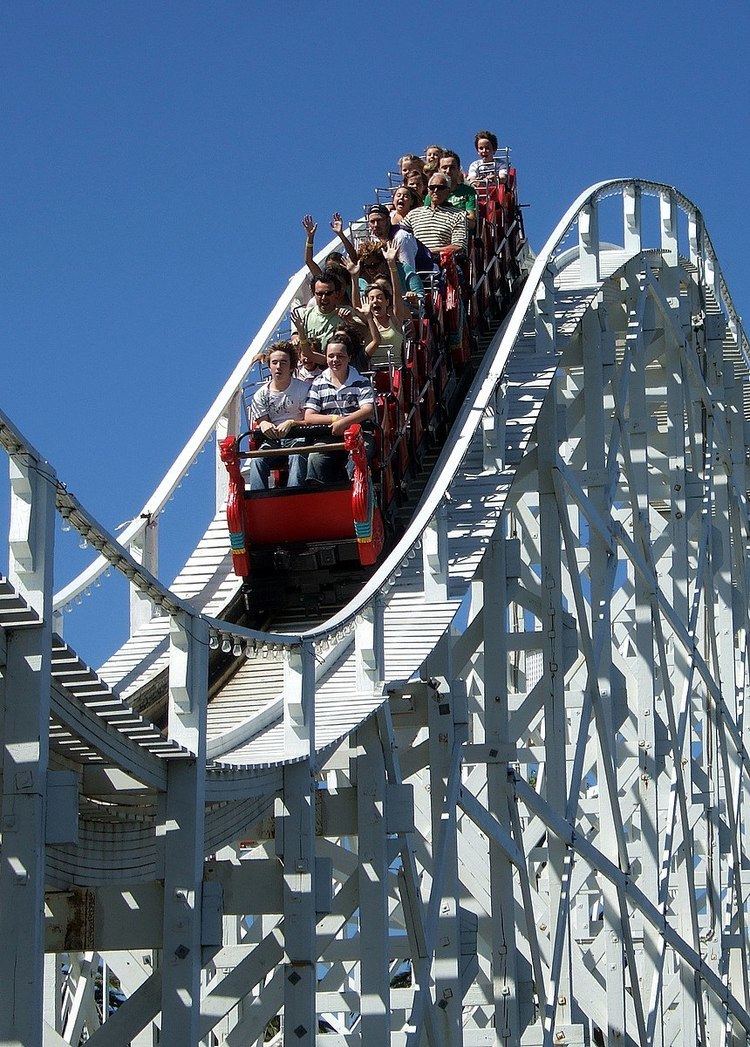A side friction coaster is an early roller coaster design that has two sets of wheels - normal road wheels, and side-friction wheels to prevent the cars from derailing on sharp curves. In comparison, modern roller coasters have a third set of wheels, called up-stop wheels, that allow them to perform steep drops, whereas side-friction coasters almost never featured drops of steeper than 45 degrees.
An even earlier design, the scenic railway, used only road wheels, and was thus capable of neither sharp turns nor steep drops, and usually required a brakeman to ride on the train and slow it down when necessary. Their name derives from the fact that they are often adorned with elaborate façades.
The side-friction coaster was invented near the beginning of the 20th century. The most common design was, by far, the stacked figure-eight layout, with dozens appearing in parks throughout the world. This version often went by names such as "Toboggan Slide", "Drop/Dip/Leap the Dips", or simply "Figure Eight", and featured tiny drops.
Other side friction coasters, such as the giant coaster at Crystal Beach Park, were built in a style similar to modern wooden roller coasters, and featured large drops and extremely rapid turns.
The invention of up-stop wheels in the 1910s allowed much more scope for height, speed, and steepness in coaster designs, leaving side friction coasters to quickly fall out of favor. Only a handful have been built since World War II, and none since 1961. Today, there are only two side-friction coasters left in the world, and eight scenic railways, since 2003, the "Runaway Coaster" at the defunct Rotunda Amusement Park in Kent, England, was demolished on April 5, 2007.
Leap the Dips at Lakemont Park in Altoona, Pennsylvania. Opened in 1902, Leap the Dips is the oldest roller coaster in the world and the last remaining side-friction roller coaster in North America. It was out of service from 1985 to 1999.Slope Shooter at the Higashiyama Zoo and Botanical Gardens, built in 1961. It has a long, winding layout, and has troughs made of steel and concrete.The Scenic Railway at Luna Park, Melbourne. Built in 1912, it is the oldest continuously operating roller coaster in the world, and the oldest roller coaster in Australia.Rutschebanen (the name literally means "The Roller Coaster") at Tivoli Gardens in Denmark. Built by Denmark native Valdemar Lebech. Opened in 1914.The Scenic Railway at Dreamland Margate in Kent, England. Opened in 1920, The Scenic Railway was granted Grade II listed status in the UK by English Heritage – the US equivalent of a national historic landmark. It had been standing but not operating (SBNO) since 2008, when a portion of the ride was destroyed in a fire. However, the Scenic Railway has undergone restoration and Dreamland reopened on 19 June 2015 following an £18m investment.The Hullámvasút at Vidámpark in Budapest, Hungary. Built in 1922, opened in 1926, after it was set on fire, this is the oldest operating roller coaster in Central Europe.The Montaña Suiza ("Swiss Mountain" in Spanish) at Parque de Atracciones Monte Igueldo in Donostia/San Sebastián, Spain. Built by Erich Heidrich and operating since 1928.The Roller Coaster at Great Yarmouth Pleasure Beach in Norfolk, England. Also built by Erich Heidrich for the Colonial Exhibition in Paris in 1929. Moved to Great Yarmouth in 1932.Rutschebanen (the name literally means "The Roller Coaster") at Dyrehavsbakken in Denmark. Built by Denmark native Valdemar Lebech. Opened in 1932.The Hochschaubahn at Wurstelprater in Vienna, Austria. Opened in 1950 as a replacement for the original, which was destroyed during World War II.Vuoristorata at Linnanmäki in Helsinki, Finland. Built by Denmark native Valdemar Lebech. Opened in 1951.
